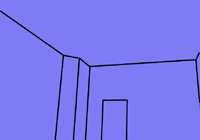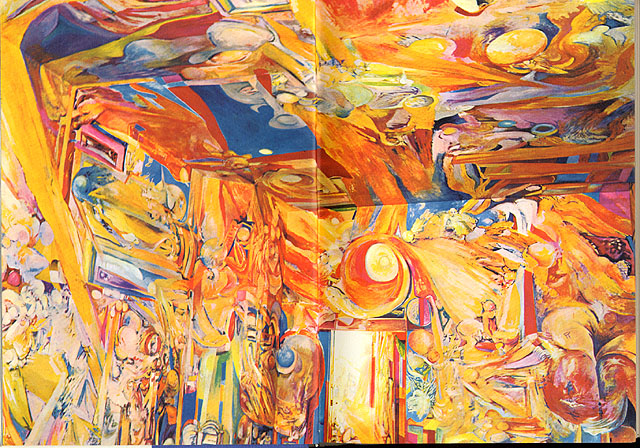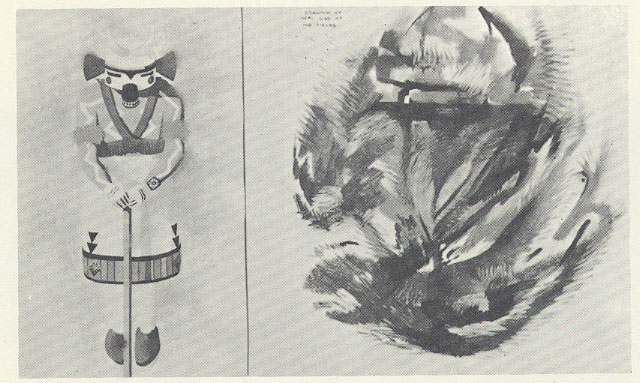
Reconstruction of the Manhattan apartment space below, onto the walls and ceiling of which the 'psychedelic temple' was painted
14 June 2005
'I'll tell you about a funny episode. Jean Houston and Robert Masters put together a book called Psychedelic Art in the sixties, and they came to me. They did an interview with me, like we're doing now, to include me in their book. And they asked me, "What kind of psychedelics do you take when you're painting?" And I said, "I don't take anything when I'm painting. When I take psychedelics I get very horny, and I start going out to nightclubs and cruising." (laughter) So they said, "Well, we can't put you in the book." I freaked out, because I wasn't in any book yet (laughter), and I said, "But I get my ideas when I'm high." And they said, "Alright, we'll put you in the book." Next they asked me for the names of other psychedelic painters, and I gave them a whole list, including Fuchs. I called them all up right away, and I told them, "Tell them that you're taking psychedelics!" And they all got in the book.' (laughter)
Quote from an interview with Mati Klarwein. (There is also another Interview).
On re-reading the stuff below (written over the past few days), it seems unclear why one should bother to "review" a book on psychedelic art— Psychedelic art, 1968, by Robert E.L. Masters and Jean Houston (I am referring to the German translation, Psychedelische Kunst)—that was published 37 years ago. I recently chanced upon it in a second-hand bookstore. Maybe I thought I should read a bit into the history of this stuff because some had commented that my rug looks psychedelic. (In fact, there is the same obsession with detail in many of the paintings featured in the book, although most psychedelic painting seems less pedantic and self-defeating than the approach followed in drawing the rug.)
However, I don't want to produce an art-critic–type serious review. I just pick out a few bits and pieces here and there. Perhaps I will try to write something about some individual works reproduced in the book.
One good reason to have started all this is that it has taken me to all sorts of places when I researched via Google what had become of the artists included in the book. For example, looking up "Mati Klarwein" (who died in 2002) eventually led me to this fictional (self)-interview (in German) which for me has an importance that will take some time for me to understand.
Image: Mati Klarwein: A grain of sand, 1965. (Picture quotation from Masters & Houston 1969: Psychedelische Kunst)
The first impression, when flicking through the images in Psychedelic art: the stuff looks somehow distant, implausible, and dull. At the same time, it gives off the faint whiff of a miniature utopia arrested in a drop of amber, inducing a nagging phantom memory of the spontaneity, carelessness, and hedonism of a way of life that probably never had a chance to survive "the system" for long. Looking at these images communicates this loss (but also the loss of delusion). It is important to remember that 'the Sixties' were the last moment in the history of the Western world when a lot of people honestly believed they were about to change the system radically, for good. (Pynchon has rendered the brutal and sad decline of this utopia in Vineland.) All political struggles after the onset of the 70's look like a gradual retreat, a retreat that still continues.
Let's re-wind and re-view this dated book, and see what else comes up when following some traces.
The work of Isaac Abrams seems to represent the default psychedelic style, if there is such thing; it features the flowery organic forms, the curvey fields reminding of sections of fractals from the Mandelbrod set, packed with concentric radiating ornaments, etc. (This painting of Abrams has been selected for the dust cover of the book.)
What stuck out for me is the stuff by Allen Atwell (see the 'psychedelic temple' below). A web search on him reveals little. He is mentioned a few times in Art Kleps Millbrook book: 'I liked Allen, but I did not appreciate his "psychedelic" paintings, which mostly looked like interlaced guts to me, and I couldn't pretend otherwise." It is this gory quality that distances Atwell's work from the kind of psychedelic aesthetics praised by the authors as almost completely devoid of the most severe affliction of humankind, namely, the neurotic, the ugly and the debased (common) that permeates so many artistic expressions of our time' (p.22, re-translated from the German translation).

Reconstruction of the Manhattan apartment space below, onto the walls and ceiling of which the 'psychedelic temple' was painted

Allen Atwell, Psychedelic temple (partial view). Picture quotation from Masters & Houston 1969: Psychedelische Kunst.
A regressive aesthetics severely limits the account of Masters and Houston, who seem determined to construct "psychedelic art" as novel, noble, positive and transgressive, doing away with the negativity of abstract expressionism and other earlier avantgarde movements. They maintain (without giving any evidence) that 'the' psychedelic artist proclaims the long overdue news that Freud is dead, and that he refuses to exhibit neuroses or express traumata in his art:
Departing from the initial pedestrian scientific sobriety designed to lull the wary reader into grudging acquiescence, the authors soon begin to float dubious terms and concepts like 'primal energy', 'genetic inheritance', 'archetypes', 'numina' and 'inner accord with the universe' without making much effort to bring some epistemological order to this mess.
In cooking up their eulogy of psychedelic art, the authors sloppily mix observations, external sources, own and reported opinions, beliefs and assertions, and experiental evidence rendered via quotes or accounts. Other movements such as surrealism are discussed only to shore up the realm they seek to map out for their mental baby, the new advanced enlightened and superior psychedelic art. In promoting it, they seem to promote themselves as ground-breaking explorers. There is a straight and short line from here to the new age kitsch that some of the artists (and Jean Houston herself with her awful mystery school) ended up producing (google, for example, Isaac Abrams' stuff — Mati Klarwein's development seems an entirely different matter, too complex to discuss here). (Just as an aside: on her web site, Jean Houston has the cheek to quote a certain Ewert H. Cousins Ph.D, Teilhard de Chardin Professor Graduate Theological Foundation Notre Dame University, as saying about herself and her collaboration with Robert Masters: '...their contribution to the field of psychology is monumental. In fact, I believe that it is the greatest contribution to the field of psychology in the last hundred years.')
Particularly telling is the complete neglect of the role of the artistic material, its qualities and productive constraints. For Masters and Houston, the ideal artistic process involves a direct (blueprint) transfer from the artist's essential vision to images or other forms of expression: '...exact memory sets in as soon as the artist begins to paint. The image "is already on the canvas" and the artist somehow knows exactly what he has to do.' (p.98). This transfer from essence to physcial form is merely a degradation: ..we are entitled to conclude that the visons even of the greatest artist are watered down once they have been realised in his sculpture, painting or architecture' (p.91).
It is evident probably only from today's perspective that the first thing this book sets out to do is to reign in the potential chaos and danger, the mind-blowing escalation and irresponsibility of the psychedelic experience. The introduction attempts to lend social respecability to the practice of drug taking by placing the outcomes of 'painting on acid' into the context of venerable art history. It insists that for the artists featured, the consumption of psychedelic drugs was done with the purpose of generating an 'enhanced' sort of art, but still an art keeping to traditional forms (paintings, mostly). In referring to a long history of human drug use for the purpose of enhancing and altering the mental experience, the authors try to construct the respectability of controlled and deliberate drug use, as distinct from drug abuse. They seem to count on (and contribute to) a seemingly irreversible trend in sixties that would lead to a progressive de-criminalisation, acceptability and ubiquity of drug-taking. With historical hindsight, this is one of the implicit and poignant errors of this book.
Such respectability can only be gained at the price of playing down the loss of control, the potentially destructive and alienating aspect of using psychedelic drugs, and the deliberate risk taken in exposing the mind to substances whose effects are unknowable. The aspect of auto-aggression (or auto-transformation with unknown outcome), which is also a token for a fundamental rejection of the system at large, is not investigated anywhere in the book. This denial of destructiveness determines the construction of the (entirely positive) 'artistic experience'. While the mind-boggling, visionary effect of drugs is welcomed, it is at the same time rendered as a mere modifier of a substance ('talent and inspiration') that is the property of the individual artist. Drugs may 'unlock' inaccessible regions of the psyche, but these regions are assumed to be nothing but hithero unexploited artist-owned mental territory, literally the surface of unconscious realms in the artist's brain. The drug simply acts as fertiliser and harvesting tool for this new land brought under cultivation.

Unnamed artist: Indian doll representing a Hopi field deity, drawn before (left side) and during (right side) the influence of psychedelic drugs. Picture quotation from Masters & Houston 1969: Psychedelische Kunst.
A key term to describe the qualities of psychedelic art is 'extraordinary' (außergewöhnlich). To be sure, the extraordinary has long been a regular diet of bourgeois art criticism. Its main characteristic is the limited time span of the experience of the extraordinary by the viewer or critic (a temporal limit that is mirrored by, or modeled on, the passing effect of the drug on the human metabolism). A brief spell of the extra gives the ordinary the common satisfying kick. It may literally work on the level of hormones (endorphines, adrenaline, or whatever). Re-entering the ordinary, perception and self-perception seem enabled or heightened for a transitional period, relaxing for a while the common numbness generated by the redundancy of the repetitive bourgeois lifestyle.
The effect of the art work is described on a range from communicating, to inducing and (yes) enhancing the psychedelic experience. On the documentary end of communicating, the art work functions like clinical evidence for weird mental states that can be studied with scientific rigor, consumed with amusement or rejected with scorn. That psychedelic art may "induce" a psychedelic experience is taken as proof that this experience is something more universal and noble than a mere drug-induced trip of an acid head. The book claims that genuine 'pychedelic' experience has long been accessible to the heightened sensitivity of artists, rendering the use of drugs by artists a natural choice to reach an already familiar 'professional' state. Staring at a piece of psychedelic art is supposed to work like a mandala in meditation. The trip itself seems constructed like an ethnographic field trip into tribal territory, where the western ethnographer daringly appropriates (steals) sacred objects. Those back home (the ordinary) seem to ask: 'What did you bring back from the extraordinary this time?' The act of painting, done under the influence of the drug or afterwards, captures the trouvailles of the trip to be admired as proof of the artist's daredevil courage and superior endurance.
Shame on you to ask such a blatantly exploitative question. Peeling away the authors' text, there are a number of quotes and reports from test persons that I like reading, because they implement in language the kind of drift of focus, or chain of transformations, from one perception to another. Here is a longer quote:
'In another kind of psychedelically augmented perception of reality one experiences, for example, the emergence of manifold faces from the flowery pattern of a couch, somewhat as they appear in Tchelitchew's 'Hide-and-Seek'. One of our test persons reported that as she was looking at such a couch, she saw "a large face with the torso of an elephant who is blowing a liquid into the face of a demon whose body he has trampled into the ground...a herculean figure is raising next to the elephant's face. Up to the loins he is covered by stone, and this marble stone looks like meerschaum, so fine and intricate. Everything seems to merge. The herculean figure is at the same time the ear of a face, and the elephant-like torso is the nose ridge of another larger, even more complex figure" '(p.94).
(to be continued)